
| lo-fi wavetable keyboard with ROM-Pack & key lighting |  |
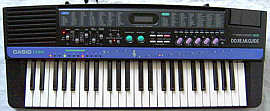 |
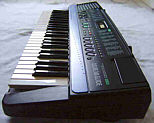 |
Unlike modern key lighting keyboards, not the keys itself but a row of tiny LEDs above the keys flash up to teach keyboard playing, but here the LEDs are placed like musical notes on note lines to show which key belongs to which note. In opposite to earlier ROM-Pack keyboards it has not only a melody guide, but also a chord training feature, that teaches to play fingered chords.
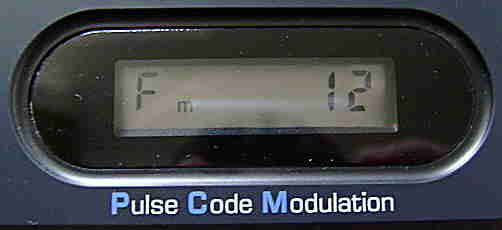 |
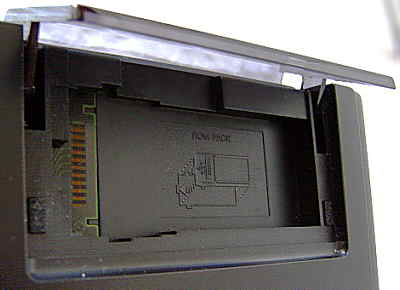 |
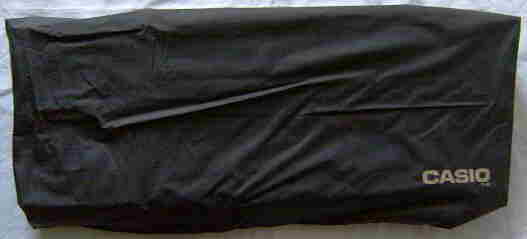 |
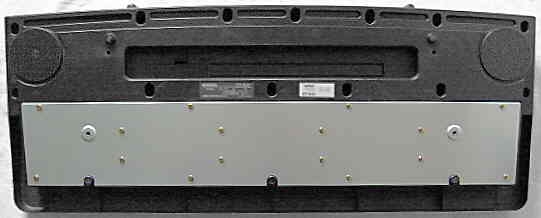 |
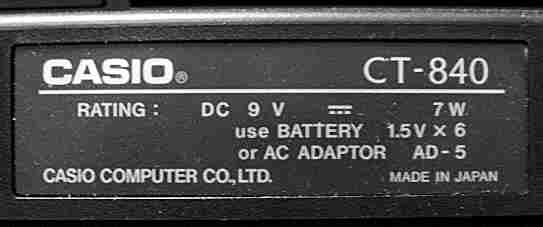 |
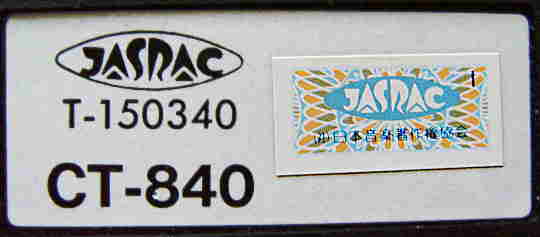 |
12 higher note keys addable (but highest 4 garble timbres).
The sound of this instrument is almost identical with Casio MA-130 (see there) but instead of the "poly/ texture" button there is a "tone mix" button to layer any 2 preset sounds, since the tone generator apparently has doubled internal polyphony. Also the "piano" sound is more natural with higher resolution and noticeable sampled attack phase. (I prefer the MA-130/ SA-series piano.) The fact that Casio omitted in this hardware the annoying button press click noise shows that it was either considered a more professional "non-toy" model or that Casio thought the LCD (which is absent in cheaper variants) will be sufficient to confirm button presses.
The "DO. RE. MI. Guide" button replaces the melody voice (also with demos etc.) with a monophonic Japanese child voice that sings the note names {"do"," re", "mi", "fa", "so", "la", "si", "do"}. Unlike MC-32, this one sings the correct pitch in the whole melody section of the keyboard and only repeats a higher octave in the octave below. Also sharps (black keys) are sung, although as note names of the corresponding naturals. The voice sings quite Engrish "le" instead of "re". The sung note is played only about 1 second long, but is truncated with even shorter note. I am not sure if this bombastically advertised hype feature really helps much with learning notes. At least the low resolution sample quality of the voice is very noisy and thus makes a nice sound effect; unfortunately it can play only monophonic.
The rhythm and accompaniment is also very similar like MA-130 (grainy lo-fi samples) with the only difference that here there is also a manual chord mode (pipe organ timbre) with rhythm off. Unfortunately it plays nothing else than standard establishment chords and stubbornly ignores any other key presses even in fingered chord mode. When new keys are pressed in the chord section, it always stops the organ chord tone for a fraction of a second, even when the new key combination continues with the same chord. (This can be also used as a sound effect.)
The 5 drumpads are very responsive and play 5 sound effects after power-on. The "phone bell" rings like a mechanical one so long the pad is held. The "laser beam" corresponds to the 3rd keyboard section of the same preset sound. The "bird tweet" is a high short synth whistle with falling pitch, the "siren 1" resembles a synth tom with falling pitch, while "siren 2" howls up with strong and fast vibrato. (Names were chosen by me since the control panel only shows icons.) The "metronome" button replaces the current rhythm with a metronome made from low and high clicking clave sounds (high for first beat of a bar, low for the others), which makes also a nice alternative rhythm, since it can be combined with the given accompaniments and toggled back and forward during running accompaniment.
The chord sequencer is fairly complex but has no permanent memory and thus looses its data by power-off and even auto-power-off, which is a severe design flaw considering the effort Casio has put into this feature.
The "melody guide" key lighting feature can use as well the 5 built-in
demo musics as external ROM- Pack cartridges, and you can even play
their music with any of the 100 preset sounds & rhythms by switching
them in between (although the programmed music may switch them back). The
built-in musics are selected when no cartridge is inserted. The song "DO-RE-MI"
always starts with "DO. RE. MI. Guide" enabled, thus singing its notes.
Beside the melody voice, you can even train fingered chord play with this
instrument, a feature that was likely introduced first with Casio MT-820
and MT-88.
hardware detailsDespite same sound and rhythm set like Casio MA-130, the CT-840 has instead of the classic SA-series CPU M6387 an "OKI M6567-04" with 80 pins.A bit strange is that there is an unused section with empty holes on the amp PCB; possibly originally a different microphone amplifier was planned here and then left blank to circumvent a PCB design flaw; the given mic amp seems to be mounted on a small daughterboard instead. The key leds are demultiplexed by 2 octal latch logic ICs 74HC373AP.
pinout M6567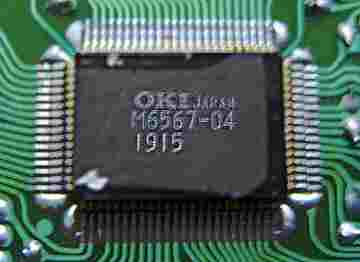 The
"OKI M6567-xx" CPU (pins count anticlockwise, xx = software number of internal
ROM) is a 80 pin SMD variant of the M6387
that (unlike older Casio keyboards) supports a matrix of key lighting LEDs
without driver transistors. Each LED is likely wired from an LEDY to an
LEDX pin; the led groups need to be demultiplexed by 2 octal latch logic
ICs (74HC373AP). Pins 13..27 seem to control the LCD. The pins 65..72 can
control a ROM-Pack port.
Without a ROM-Pack connected, the key lighting uses (demo) songs from its
internal ROM. Unlike M6387 it supports a larger key matrix (up to 61 keys)
and has more internal ROM, which is used for additional samples (piano
timbre, "DO. RE. ME. Guide") and SongBank (apparently up to 64 songs).
Due to 16 note polyphony it is clocked twice as high (43.45 MHz, turns
slightly warm). But despite improvements this is still an entry level keyboard
CPU with neither stereo nor midi support. The non-persistent chord memory
in CT-840 suggests that this CPU contains no SRAM and disables DRAM refresh
during standby to conserve batteries. The
"OKI M6567-xx" CPU (pins count anticlockwise, xx = software number of internal
ROM) is a 80 pin SMD variant of the M6387
that (unlike older Casio keyboards) supports a matrix of key lighting LEDs
without driver transistors. Each LED is likely wired from an LEDY to an
LEDX pin; the led groups need to be demultiplexed by 2 octal latch logic
ICs (74HC373AP). Pins 13..27 seem to control the LCD. The pins 65..72 can
control a ROM-Pack port.
Without a ROM-Pack connected, the key lighting uses (demo) songs from its
internal ROM. Unlike M6387 it supports a larger key matrix (up to 61 keys)
and has more internal ROM, which is used for additional samples (piano
timbre, "DO. RE. ME. Guide") and SongBank (apparently up to 64 songs).
Due to 16 note polyphony it is clocked twice as high (43.45 MHz, turns
slightly warm). But despite improvements this is still an entry level keyboard
CPU with neither stereo nor midi support. The non-persistent chord memory
in CT-840 suggests that this CPU contains no SRAM and disables DRAM refresh
during standby to conserve batteries.
The versions of "OKI M6567-xx" ("xx" = software number of internal ROM)
seem to differ mainly in the count of internal demo songs and supported
keyboard length. (Likely all versions can poll 61 keys, although most instruments
have only 49; e.g. in MA-220 keys above 57 distort.) In later software
versions (likely all with >15 song, selected through cipher buttons) all
61 keys work, but many features were removed to save rom space for more
melodies and partly more or higher resolution samples. So CTK-200 (software
number 11) lacks melody guide modes, ROM-Pack support, DoReMe-Guide and
even the drumpad samples were omitted (silent, but still mute rhythm for
1 bar, one pad sounds a piano note). These all have a changed preset sound
set (boring) with more sample based preset sounds. The preset rhythm set
(at least their order or names) varies among later variants. CTK-450 has
technically 64 songs (32 of them "free sessions") but only 8 cipher buttons
for its 64 sounds and rhythms, so likely others were omitted to save rom
space. (It is unknown if the 2 omitted cipher buttons access some of them
as eastereggs.)
This pinout was concluded from the service manuals of Casio CTK-450
(has neither ROM-Pack nor key LEDs, 32 song bank, CPU="OKI M6567-15"),
ML-2
and SK-8.
The pins are arranged in a way that in simple instruments (no ROM-Pack, key lighting, lcd) many adjacent pins can be left unused to ease PCB layout. In MA-220 pin 36 seems to output a HF clock signal, that is too fast to see on my analogue oscilloscope. Its ROM-Pack port pins output a short lo-pulse only before a demo song starts, so it likely polls for ROM-Pack presence and then turns the port off, which doesn't seem to be connected with an internal bus. Pin 64 stays hi and thus is not keyboard matrix output. The LCD output waveform has 4 voltage steps. In CTK-200 pin 8 is the unused 'Melody on/off' button LED (off=hi). Despite it supports no key lighting modes, during songs pins 4..7 and 74..80 still output multiplexed key led signals (pin 11 stays lo). Also the lcd port (pin 13..27) is still alive and changes with selected chord or numbers. But the ROM-Pack port (pin 65..72) always stays hi (also during song selection), thus support was likely removed to save rom space. Strange is that both in MA-220 and CTK-200 the unused CPU pins 1, 4..7, 11..26, 65..72, 74..80 (led, lcd and rom pack port) are wired to empty solder pads, but not e.g. the likewise unused pin 58. This suggests that only those with solder pads were important for factory tests and so e.g. may be suited to access internal ROM or RAM contents through a hidden test mode. |
Smaller 100 ToneBank instruments with ROM- Pack slot and 5 drumpads were the mini keyboard Casio PT-88 and its midsize variant PT-380. The oldest (and most noble sounding) ROM-Pack keyboard was Casio MT-800.
It can be considered a slightly higher grade variant of MA-130 with 2 speakers, additional drumpads, simple chord sequencer and manual chord mode.
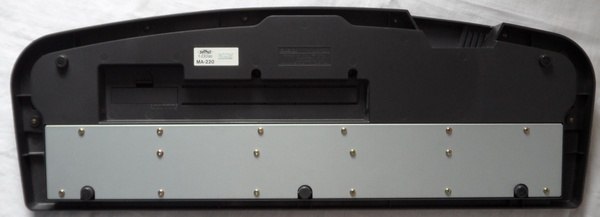 |
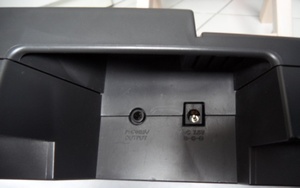 |
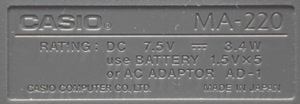 |
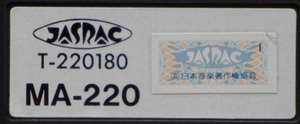 |
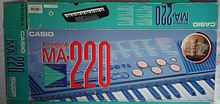 |
 |
 |
likely all features of CT-840 addable. 12 higher note keys addable (but highest 4 garble timbres).
circuit bending detailsThe Casio MA-220 is based on the single-chip CPU "OKI M6567-05", which except different demos seems identical with the "M6567-04" of CT-840. The op-amp "XRAI 5218" (PCB label M5218APR) seems to be used as a noise gate (concluded from CTK-450 service manual) to fight static digital noise - by lack of proper shielding without much success. The power amp is a "Casio LA5668N, 284" (10 pin SIL).
keyboard matrixThe pinout of the 15 pin ribbon cable JA (counting right to left) is:KI2, KI3, KI4, KI5, KI6, KI7, KO2, KO4, KO5, KO6, KO7, KO8, KO3, KO1, KO0 KI0 is on the 2nd diode of the horizontal diode row in the middle of the PCB. KI1 is at the 3 diodes with the "9" near the 'mode' slide switch. KO9..14 are accessible on the PCB back at corresponding panel button contacts and KO9 only as unused CPU pin. I examined this keyboard matrix by myself, based on the Casio CTK-450
service manual. Missing and different functions were concluded from behaviour
of my CT-840, which matrix seems identical, so there are tons of eastereggs.
The input lines are active-high, i.e. react on +Vs. Any functions can
be triggered by a non- locking switch in series to a diode from one "out"
to one "in" pin.
I am not sure what this was intended for. It may be only a test mode (pressing the button again immediately restarts that beat at the 'one', which sounds crude), but it also may be a record mode of some kind of sequencer (like a "custom drummer") that I didn't get to work. Possibly it is just dead code left over from something else. The hihat beat with muted chord section may be related to the lead-in condition before starting a demo or rompack song; also here only keys and drumpads work and chord section is mute. The only difference is that the 'beat/tone' button toggles its led, while the strange mode doesn't. |
The instrument has 15 nicely arranged demo melodies, those main voice can be muted with the 'song melody' switch (which exits the song). The melodies are:
| removal of these screws voids warranty... | ||
 |
||
|
|